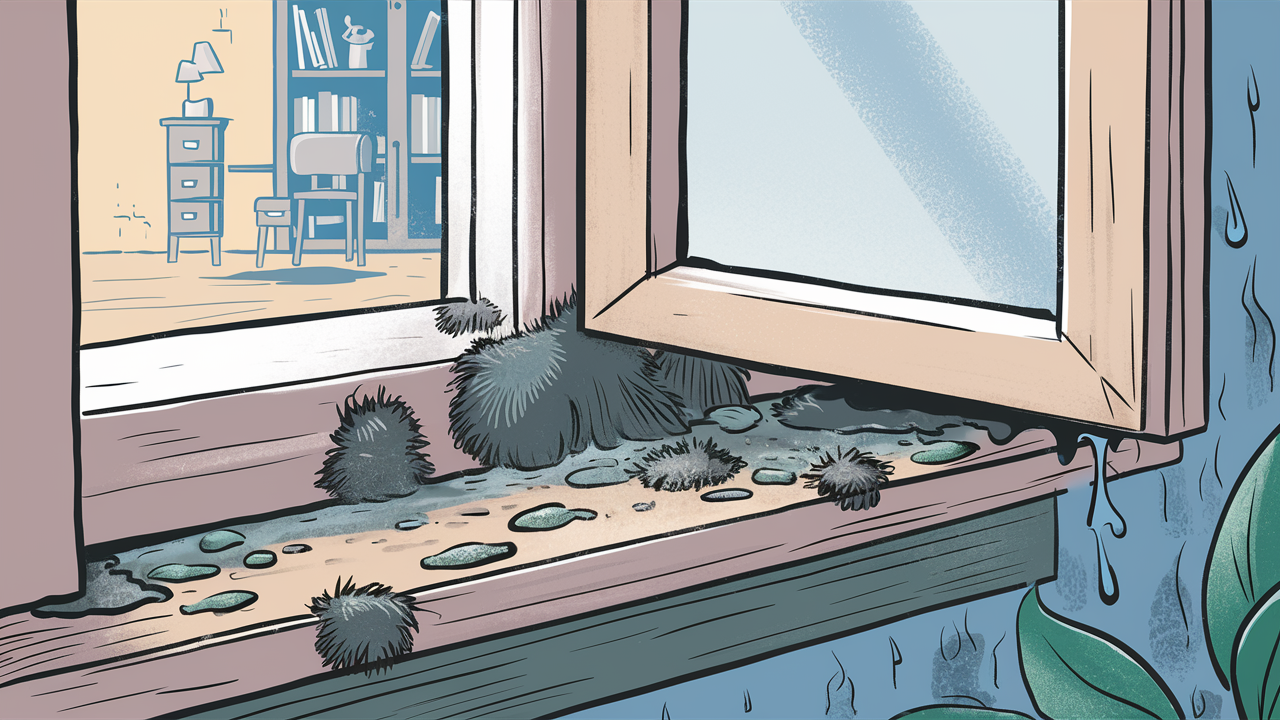Mold On Window Sills And Frames: Signs, Causes And Removal Tips
TL;DR: To remove mold from window sills, begin by cleaning with undiluted white vinegar or a 1:3 bleach-to-water solution. Apply the mixture, let it sit for 20 minutes, then scrub with a brush or toothbrush. For persistent mold, use commercial products like Concrobium Mold Control or HG Mould Remover. After cleaning, dry the area thoroughly. Improve ventilation by opening windows for 15 minutes daily and using exhaust fans in bathrooms and kitchens. Install a dehumidifier to maintain indoor humidity below 50%. Seal gaps around windows with caulk and apply mold-resistant paint containing fungicides for long-term prevention. Implement weekly cleaning of window sills to remove condensation using a microfiber cloth. If mold persists, check for underlying issues such as leaks or poor insulation. Always wear protective gear (gloves, mask, goggles) when cleaning mold to avoid health risks associated with spore inhalation.
Mold growth on wooden window sills from condensation in winter is a common issue for homeowners. You might notice green or orange fuzzy patches forming in these areas due to water (moisture). This mold isn’t just unattractive – it can also cause problems if left unchecked.
This guide will cover key information about handling mold on window sills. We’ll discuss how to identify mold, explain mold remediation techniques, and best ways to clean mold from wooden windows. Our goal is to help you restore your windows to a clean, mold-free condition.
Let’s examine how to tackle fuzzy mold growth on window seals and implement a strategy to get rid of mold on window sills.
Types Of Molds On Window Sills
Window sills often have mold due to moisture and high humidity. Common types include Cladosporium, Aspergillus, and Penicillium. Not all molds are harmful, but some can cause health issues.
Window sills are prone to mold growth because of condensation and moisture buildup. Here are the most common types of mold you might find:
1. Cladosporium
Cladosporium is very common on window sills. Here’s what you need to know:
- Look: Often appears as dark green, brown, or black spots
- Where it grows: Likes both warm and cool areas
- Common spots: Often found on fabrics and wood, including window sills
- Health effects: Can cause allergies and breathing problems, especially bad for people with asthma
2. Aspergillus
Aspergillus is another mold you might find on window sills:
- Look: Can be white, green, or black
- Where it grows: Prefers wet places with temperatures between 53°F and 149°F
- Common spots: Often found on food and indoor surfaces, including window sills
- Health effects: Can cause allergic reactions, lung infections, and a condition called hypersensitivity pneumonitis
3. Penicillium
Penicillium is easy to spot because of how it looks:
- Look: Often blue or green in color
- Where it grows: Likes materials damaged by water
- Common spots: Frequently found on window sills, especially those affected by moisture
- Health effects: Can cause allergies, sinus infections, and lung inflammation
4. Stachybotrys Chartarum (Black Mold)
Stachybotrys chartarum, often called “black mold,” isn’t as common on window sills but can sometimes be found there:
- Look: Appears slimy and black
- Where it grows: Typically grows in damp environments
- Common spots: Can be found on window sills, especially if there’s a serious moisture problem
- Health effects: Linked to more severe health risks due to toxins it produces, including allergies, breathing problems, ongoing sinus infections, tiredness, and depression
Identifying Mold On Window Sills
Figuring out exactly what type of mold is on your window sills can be tricky without professional testing. However, here are some general things to look for:
- Look: Mold on window sills often appears as dark spots, ranging from green to black in color.
- Feel: Some molds might feel fuzzy or slimy.
- Smell: A musty or earthy smell can mean there’s mold growing.
- Pattern: Mold often grows in circles or clusters.
Keep in mind that not all dark spots on window sills are mold. Sometimes, water damage can pull natural colors from wood, creating discoloration that looks like mold.
Why Mold Grows On Window Sill?
Mold on window sills is often caused by condensation. This happens when warm, damp air meets cold surfaces. It’s more common in winter, when indoor heating clashes with outdoor cold. The resulting moisture creates ideal conditions for mold growth.
For mold to thrive, it also needs organic material, such as dust. Both older homes with drafts and newer, well-sealed homes can have mold problems due to condensation. In tightly sealed homes, poor ventilation can trap moisture, leading to condensation issues.
Moisture in homes comes from various sources. These include cooking, bathing, drying clothes indoors, and even breathing. To prevent mold, keep indoor temperatures at least 14-15°C throughout your home. Ensure proper ventilation and maintain indoor humidity between 50-60%. Use extractor fans effectively, especially in bathrooms and kitchens. These fans should run for 10-15 minutes after use and be cleaned regularly.
Fans with humidistats are useful for better humidity control. Dehumidifiers can also help maintain optimal humidity levels. Clean and maintain windows and sills regularly, and keep trickle vents clear to prevent mold growth.
In new buildings, ongoing mold problems might indicate construction defects. Residents should talk to builders or relevant authorities like the NHBC. Some solutions include using mold-resistant paints, moisture traps, and expanding foam to fill gaps around window frames.
| Activity | Moisture Contribution |
|---|---|
| Cooking | High |
| Showering | Very High |
| Laundry | Moderate to High |
| Breathing | Low but Constant |
| Plants | Low to Moderate |
How To Remove Mold From Windowsill?
To remove mold from windowsills, use vinegar, hydrogen peroxide, or commercial mold removers. Ensure proper ventilation, use dehumidifiers to control humidity, and regularly clean and inspect windows. Prevent mold recurrence by sealing gaps, improving insulation, and maintaining a low indoor humidity level.
Here are the steps you can follow to get rid of mold on window sills and frames:
Identify The Mold Problem
Examine your windowsills for signs of mold, which can appear as black, white, pink, green, yellow, or brown patches. Note that not all dark-colored mold is the dangerous “black mold” (Stachybotrys chartarum). Mold often appears in areas with high condensation, poor ventilation, or consistent dampness.
Gather Cleaning Supplies
Gather the necessary cleaning supplies:
- Undiluted white vinegar
- 3% hydrogen peroxide
- Commercial mold removers (e.g., Concrobium, Cillit Bang, HG Mould Remover)
- Baking soda
- Bleach
- Protective gear (gloves, masks, goggles)
- Spray bottles, brushes, and rags
Prepare The Cleaning Area
Open windows to improve ventilation. Put on protective gear including gloves, a mask (N95 respirator if possible), and goggles. Remove any items near the windowsill to prevent contamination. If dealing with a large mold infestation (more than 10 square feet), consider consulting a professional.
Choose Your Cleaning Solution
Select an effective mold-killing solution to clean mold on window sills. Options include:
- Undiluted white vinegar (preferably cleaning vinegar with 10% acetic acid)
- 3% hydrogen peroxide
- Concrobium Mold Control
- Diluted bleach solution (1 part bleach to 3 parts warm water, but avoid on porous surfaces)
- Baking soda paste (mixed with water)
Apply The Cleaning Solution
Spray or apply your chosen solution generously on the moldy areas. For hydrogen peroxide, spray it on the mold, let it sit for 10 minutes, scrub with a brush, and wipe clean. Hydrogen peroxide kills mold spores, penetrates surfaces, and prevents regrowth.
If using vinegar to clean mold on window sill, spray it on the moldy area. Leave it for an hour, then wipe clean. Repeat as necessary. Vinegar is natural, safe for most surfaces, and effective against many mold types.
If you are using baking soda, ,ake a paste with baking soda and water, apply to the moldy area, scrub, and rinse. Baking soda is natural, deodorizes, and helps prevent mold recurrence.
If using Concrobium, follow the product instructions. Let the solution sit for 30 to 60 minutes to penetrate the mold.
Scrub The Affected Area
Use a brush, old toothbrush, or sponge to gently scrub the moldy areas. Pay special attention to corners and crevices where mold tends to accumulate. For metal window tracks, an old toothbrush can be particularly effective.
Address Underlying Moisture Issues
Identify and fix sources of excess moisture. This may involve:
- Using a dehumidifier to maintain indoor humidity between 30-50%
- Improving ventilation with exhaust fans in bathrooms and kitchens
- Repairing any leaks around windows
- Ensuring proper insulation to prevent condensation
Apply Preventive Measures
To prevent mold recurrence on window sills:
- Wipe down windowsills daily to remove condensation
- Use a squeegee or window vacuum after showers or cooking
- Keep windows open when possible to improve air circulation
- Consider using mold-resistant paint on windowsills
- Apply window insulation kits or films to reduce condensation
Implement Regular Maintenance
Establish a routine for windowsill maintenance:
- Clean windowsills weekly with a mold-inhibiting solution
- Check for signs of mold or excess moisture regularly
- Keep indoor plants away from windowsills to reduce humidity
- Ensure trickle vents (if present) are open and unobstructed
Get Professional Mold Removal For Your Windows Today
Maintaining mold-free window sills is crucial for your home’s health and safety. If you’ve tried these methods but still struggle with persistent mold, it’s time to call in the professionals. Our dedicated mold remediation team specializes in thorough and effective mold removal specifically for windows and sills. Don’t let mold compromise your indoor air quality and well-being. Contact us today at (901) 250-0431 to schedule a free inspection and ensure a mold-free environment for your home.

